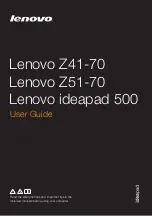
USB Power Delivery
The USB PD specification is also closely intertwined with USB Type-C. Currently, smartphones, tablets, and other mobile devices often use
a USB connection to charge. A USB 2.0 connection provides up to 2.5 watts of power — that'll charge your phone, but that's about it. A
laptop might require up to 60 watts, for example. The USB Power Delivery specification ups this power delivery to 100 watts. It's bi-
directional, so a device can either send or receive power. And this power can be transferred at the same time the device is transmitting
data across the connection.
This could spell the end of all those proprietary laptop charging cables, with everything charging via a standard USB connection. You could
charge your laptop from one of those portable battery packs you charge your smartphones and other portable devices from today. You
could plug your laptop into an external display connected to a power cable, and that external display would charge your laptop as you used
it as an external display — all via the one little USB Type-C connection. To use this, the device and the cable have to support USB Power
Delivery. Just having a USB Type-C connection doesn't necessarily mean they do.
USB Type-C and USB 3.1
USB 3.1 is a new USB standard. USB 3's theoretical bandwidth is 5 Gbps, while USB 3.1 Gen2 is10Gbps . That's double the bandwidth, as
fast as a first-generation Thunderbolt connector. USB Type-C isn't the same thing as USB 3.1. USB Type-C is just a connector shape, and
the underlying technology could just be USB 2 or USB 3.0. In fact, Nokia's N1 Android tablet uses a USB Type-C connector, but underneath
it's all USB 2.0 — not even USB 3.0. However, these technologies are closely related.
Intel Optane memory
Intel Optane memory functions only as a storage accelerator. It neither replaces nor adds to the memory (RAM) installed on your computer.
NOTE:
Intel Optane memory is supported on computers that meet the following requirements:
•
7th Generation or higher Intel Core i3/i5/i7 processor
•
Windows 10 64-bit version or higher
•
Intel Rapid Storage Technology driver version 15.9.1.1018 or higher
Table 2. Intel Optane memory specifications
Feature
Specifications
Interface
PCIe 3x2 NVMe 1.1
Connector
M.2 card slot (2230/2280)
Configurations supported
•
7th Generation or higher Intel Core i3/i5/i7 processor
•
Windows 10 64-bit version or higher
•
Intel Rapid Storage Technology driver version 15.9.1.1018 or
higher
Capacity
16 GB
Disabling Intel Optane memory
CAUTION:
After disabling Intel Optane memory, do not uninstall the driver for Intel Rapid Storage Technology as it will result in a
blue screen error. The Intel Rapid Storage Technology user interface can be removed without uninstalling the driver.
12
Technology and components
Содержание Vostro 5481
Страница 1: ...Dell Vostro 5481 Service Manual Regulatory Model P92G Regulatory Type P92G001 ...
Страница 5: ...Contacting Dell 75 Contents 5 ...
Страница 47: ...g Open the display assembly at an angle of 90 degrees Removing and installing components 47 ...
Страница 49: ...Removing and installing components 49 ...













































